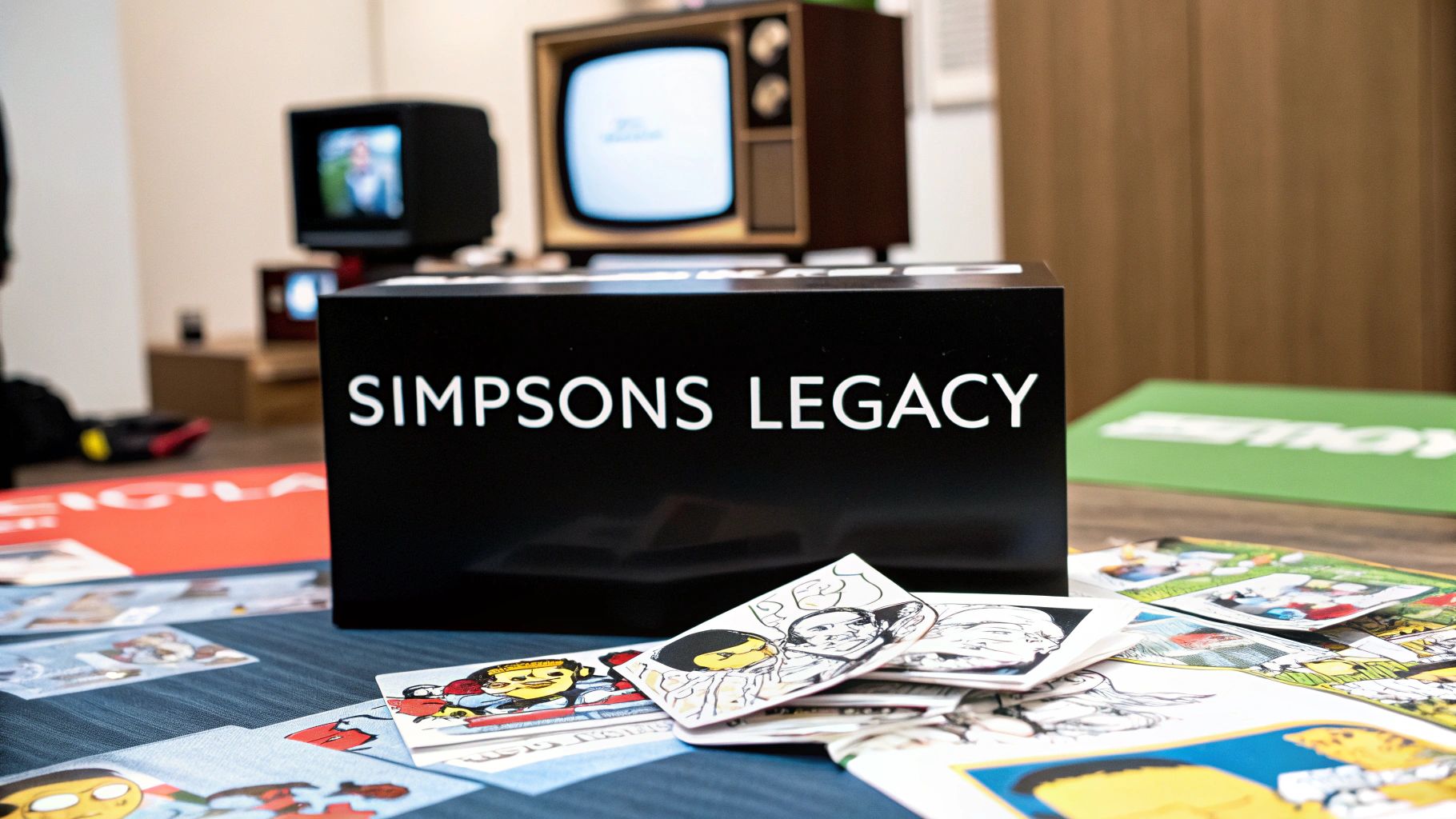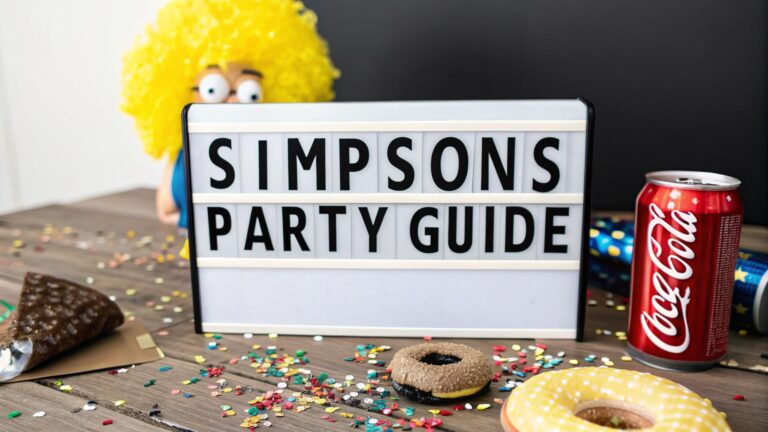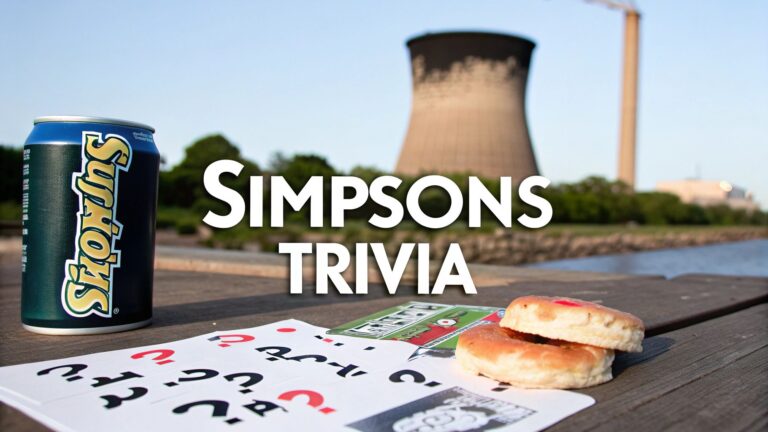For over 30 years, The Simpsons has done more than just make us laugh—it has changed television and how we see the world. This is not just a cartoon; it’s like a funny mirror held up to our society, showing all our good and bad sides with a cleverness that’s still hard to beat.
How The Simpsons Changed Pop Culture Forever
Before The Simpsons came along, cartoons in America were mostly seen as stuff for kids. The idea of a cartoon for adults on in the evening, full of smart jokes about society, was a big risk. But when it first aired on December 17, 1989, the show became a hit all over the world.
The fact that it’s still around says a lot. The Simpsons is the longest-running scripted show in U.S. TV history, with over 750 episodes and still going. Its genius is that it has lasted so long and managed to stay in touch with the times. You can read more about the show’s amazing run and its effect on pop culture on ToonsMag.
So, what was the secret? The Simpsons taught us a new way to watch TV. It trusted the audience to be smart enough to get the joke without having it explained. The humor had different layers: kids could laugh at Homer’s clumsy accidents, while adults understood the clever references to politics, books, and old movies.
To get a better idea of how big its influence is, let’s break down the main areas where the show made its mark.
Key Areas of The Simpsons’ Cultural Impact
| Area of Impact | Brief Description |
|---|---|
| TV Satire | It set a new standard for evening cartoons by mixing social criticism with humor. |
| Language & Words | It gave us words and phrases like “D’oh!” and “cromulent” that people use in real life. |
| Memes & Internet Culture | It provided tons of images and GIFs that are easy to share and relate to. |
| Merchandise | It became a model for how to turn a cartoon into a billion-dollar brand. |
| Fans & Community | It created a huge group of fans around the world who talk about and celebrate every part of the show. |
This table is just a quick look. Each of these areas shows how a simple cartoon family from Springfield became a part of our culture.
A New Standard for Satire
The show’s real genius is how it handles serious topics in a light and funny way. It uses the colorful, cartoon world of Springfield to comment on everything from greedy companies and corrupt politicians to the messy parts of family life.
The Simpsons didn’t just make us laugh—it made us think. It pushed us to look closer at the rules and groups we often accept without thinking. This special mix of humor and sharp criticism created a model that many other shows, both animated and live-action, would copy for years.
The show’s real legacy isn’t just in what it made fun of, but in how it taught a generation to question authority and find humor in the messiness of everyday life. It turned satire into a popular form of art.
An Enduring Legacy
You can still feel the show’s impact everywhere today, not just on TV but in how we talk and what we share online. Its most famous gags and one-liners have become a kind of cultural shorthand.
Many of the best Simpsons episodes of all time are filled with scenes and jokes that are just as funny and meaningful now as they were decades ago. The yellow family from Evergreen Terrace did more than just make us laugh—they became one of the most important voices of their time, and their influence is still felt in our world.
Rewriting the Rules of Television Comedy
Before The Simpsons, cartoons in America were mostly for kids. You would see them on Saturday mornings, between commercials for cereal. The idea of a cartoon in the evening—one that made fun of adult life—was basically unheard of. But The Simpsons didn’t just challenge that idea; it blew it up, proving that cartoons could be home to some of the smartest, sharpest comedy on TV.
This show wasn’t just another family sitcom. It was more like a secret weapon, sneaking clever social commentary into people’s living rooms while looking like a silly cartoon. The writers created a whole new style of humor that didn’t treat the audience like kids—it trusted them to get the joke.
A New Blueprint for TV Animation
The Simpsons didn’t just break the mold; it made a new one. It proved to TV bosses that there was a huge, undiscovered audience that wanted cartoons for adults. This one brave move opened the doors for a whole wave of shows that came after it, from South Park and King of the Hill to Family Guy and Bob’s Burgers.
Honestly, it’s hard to imagine what TV comedy would even look like today without the path The Simpsons created. They didn’t just make a successful show; they started a whole new category of TV that’s still popular.
The show’s greatest legacy was showing the world that animation isn’t a type of show—it’s a tool. It could tell any story you wanted, whether it was funny, emotional, or critical of society, just as well as any live-action show.
It became a cultural landmark. By its 31st season, the show had made hundreds of episodes, a movie, and a huge franchise of video games, comic books, and even theme park rides. The TV industry noticed, giving it 31 Primetime Emmy Awards, 34 Annie Awards, and 2 Peabody Awards.
The Power of Layered Humor
So, what made the writing so good? Think of it like a three-layer cake, where every member of the family could find something to enjoy.
- For Kids: The top layer was all bright, colorful physical comedy. Homer falling down the stairs or Bart’s classic prank calls were easy, simple laughs for younger viewers.
- For Adults: If you looked a little deeper, you’d find a rich layer of pop culture references, sneaky political jokes, and historical references that most kids wouldn’t get.
- For Everyone: The base of it all was a surprising amount of heart. The Simpsons’ family problems, though very exaggerated, were always based on something real that people could relate to.
This multi-layered style was a game-changer. It meant families could actually watch a show together, with everyone getting something different out of it. The show never dumbed itself down; it challenged viewers with a fast pace of jokes and subtle gags in the background that made you want to watch again.
A New Standard for Writing and Celebrity Guests
The Simpsons also completely changed how TV shows used celebrity guest stars. Before, famous actors usually just showed up for a quick, often awkward, appearance to boost ratings. But this show fit them into the story naturally, often in funny ways that made fun of themselves.
Celebrities weren’t just playing themselves; they were playing real characters, and many of them were happy to joke about their own public image. This made their appearances feel like they belonged and added another layer to the comedy.
Behind the scenes, the show’s writing room became famous. It set a new high bar for television writing, mixing silly humor with smart satire. That focus on quality is a huge reason why the Simpsons’ cultural impact is still felt so strongly. The show didn’t just get a huge audience, it earned the deep respect of the entire entertainment industry.
How Homer and Bart Changed the Way We Talk
Ever stub your toe and yell “D’oh!”? Or have you ever jokingly called something perfectly fine “cromulent”? If you have, then you’re speaking a version of English that’s been flavored by The Simpsons. This show didn’t just stay on our screens, it jumped right out and started shaping the words we use every day.
The show’s impact on our language is a huge part of its cultural legacy. Catchphrases weren’t just funny lines, they became a kind of cultural shortcut. Think about it. Mr. Burns’ evil, finger-tapping “Excellent” or Bart’s rebellious “Eat my shorts!” can paint a whole picture with just a word or two. It’s like an old-school version of an emoji.
It’s very rare for a TV show to add its own made-up words to the dictionary and have them stick around for so long. This achievement with language is almost as impressive as the show’s strange habit of predicting the future. If you’re curious about that, you should check out our deep dive into the wildest Simpsons predictions that came true.
This talent for language was also a key part of the show’s smart social satire.
The image above really shows how the show used its humor and special words to comment on society, wrapping its criticisms in words and phrases that have stuck with us for decades.
From Springfield to the Dictionary
The show’s influence isn’t just fan talk; it’s been officially recognized by the people who write the dictionary. Homer’s famous sound of frustration, “D’oh!,” was officially added to the Oxford English Dictionary back in 2001.
That’s a big deal. It wasn’t just a cute nod to pop culture. It was an official acceptance that a cartoon catchphrase had become a real, working part of the English language, understood by millions of people all over the world.
And it didn’t stop there. Words like “cromulent” (meaning acceptable or okay) and “embiggen” (to make bigger) started as one-time jokes. But fans loved them so much they pulled them out of the show and into real life, filling little gaps in our language we never knew we had.
Famous Phrases The Simpsons Gave Us
To really get a sense of the show’s huge impact on language, it helps to see the phrases side-by-side. Here’s a quick look at some of the most famous expressions that jumped from Springfield into our daily conversations.
| Phrase | Character | Common Meaning |
|---|---|---|
| D’oh! | Homer Simpson | A sound of frustration when you realize you’ve made a silly mistake. |
| Eat my shorts! | Bart Simpson | A defiant, rebellious comeback, like saying “Get lost!” |
| Excellent! | Mr. Burns | An evil, drawn-out phrase used when a villain’s plan is working. |
| Don’t have a cow, man! | Bart Simpson | A casual way to tell someone to calm down and not overreact. |
| Ha-ha! | Nelson Muntz | A simple, mocking laugh used to point out someone else’s bad luck. |
| Okily dokily! | Ned Flanders | An overly cheerful and friendly way of saying “okay.” |
From TV Screen to Timeless Internet Memes
The Simpsons may have been the king of television in the 20th century, but its second life in the digital age has been even more impressive. The show’s huge collection of episodes has become a never-ending source of content for the internet, offering the perfect funny picture for just about any situation you can think of. Scenes that first aired decades ago are often more famous today as memes than they ever were on TV.
This isn’t just a lucky accident. With over 750 episodes made, the show is a goldmine of gags, one-liners, and reaction shots. This huge amount of material makes it perfect for online culture, where a single, well-chosen image can say much more than a block of text.
The Anatomy of a Perfect Simpsons Meme
So what is it about a 90s cartoon that makes it so easy to turn into memes today? It really comes down to a few key things. The show’s long-term influence is a great example of reusing content for social media, showing how classic material can be used again and again in new ways.
For starters, the art style is perfect for it. The characters have simple, bold designs that make their emotions easy to see right away, even in a blurry GIF. Think of Homer slowly backing into a hedge, you don’t need a single word to understand he feels awkward and wants to escape.
The real magic of The Simpsons as a meme factory is its emotional honesty. The humor is often silly, but the characters’ feelings, frustration, joy, embarrassment, confusion—are deeply human and relatable to everyone.
That relatability is the secret. Whether it’s Ralph Wiggum saying “I’m in danger” or Bart getting hit with a chair, these moments perfectly capture feelings that are often hard to put into words. That makes them the perfect reaction images for social media, group chats, and online forums everywhere.
Iconic Memes That Refuse to Fade
Some Simpsons memes have become such a big part of internet culture that they’ve practically become their own language. They are constantly being remixed and used for new events, proving the show’s comedy was built to last.
Here are just a few famous examples that show this incredible staying power:
- Homer Backing into the Bushes: Taken from the episode “Homer Loves Flanders,” this clip is the universal symbol for wanting to get out of an awkward situation. It’s the perfect image for when you just want to disappear.
- Steamed Hams: What started as a weird, funny scene between Principal Skinner and Superintendent Chalmers has created its own fan base. Fans have re-edited it into musicals, movie trailers, and every art style you can imagine, all to celebrate its perfectly silly dialogue.
- Lisa Simpson’s Presentation: A simple shot of Lisa at a projector has become the go-to template for sharing a truth that’s hard to accept. People just edit the text on her presentation slide to make their point, borrowing Lisa’s serious look for a bit of comedic effect.
And that’s just a few of them. From “Old Man Yells at Cloud” to the “Marge Krumping” GIF, the show is an almost endless source of material.
This constant reinvention is a huge part of why the Simpsons cultural impact is still so strong. The show isn’t some old thing we just look back on. It’s a living, breathing part of how we talk online, with new fans discovering its genius and using it for their own humor every single day. The show isn’t just surviving; it’s thriving.
The Enduring Power of the Golden Age
Talk to any huge Simpsons fan, and you’ll eventually hear them talk about the “Golden Age.” It’s a term they use with a lot of respect, and for a good reason. This amazing period, usually said to be from seasons 3 to 9, wasn’t just when the show was at its best—it was a high point for all of television comedy.
This was when the writers perfected their formula: a brilliant mix of very smart, fast-paced jokes and a surprising amount of real emotion. Each episode was totally packed with clever social commentary, unforgettable characters, and so many background jokes that you had to rewatch to catch them all. It found a perfect balance between silly chaos and real, relatable family moments.
Bartmania and Hitting the Big Time
The early ’90s also gave us “Bartmania.” Suddenly, the spiky-haired kid with the bad attitude was a global star. Bart’s catchphrases were everywhere—on t-shirts, lunchboxes, you name it. His rebellious spirit just connected with a whole generation. This was the show at its most powerful, starting conversations and shaping pop culture like nothing before it.
The Golden Age is what made The Simpsons a cultural landmark. While the show has had other big moments, like the 2007 movie, its biggest influence is almost always traced back to this specific time. You can find some great discussions about the show’s changing cultural relevance on NoHomers.net.
The Golden Age was a perfect storm in TV history. You had a legendary group of writers, complete creative freedom, and an audience that was finally ready for smarter, sharper comedy.
Sticking Around in a New Media World
It’s easy to say the show just “got worse” after the Golden Age, but that’s not the whole story. The world of television changed. When The Simpsons started, you had just a few channels to choose from. Now? Viewers are spread out across hundreds of networks and streaming services. No single show can grab the world’s attention the way The Simpsons once did.
The series also had to deal with the impossible job of staying new and exciting after decades on the air. Later seasons might not be as good as the ’90s classics, but the show’s ability to keep going is an achievement itself. The legacy of that Golden Age is a huge part of the Simpsons cultural impact, setting a standard so high that even the show itself has a hard time matching it. That famous style, especially the yellow skin, is still known everywhere. We actually have a whole article about the creative reasons why The Simpsons are yellow.
Got Questions? We’ve Got Answers
Even after all this talk about its huge influence, you probably still have a few questions. Let’s go over some of the most common ones about The Simpsons‘ place in history and its amazing legacy.
We’ll clear up a few things about its history, its humor, and where it is today.
What’s the Single Biggest Thing The Simpsons Did for Culture?
If you have to pick just one thing, it’s this: The Simpsons made cartoons for adults a real thing. It single-handedly made animation a respected way to create smart comedy and social commentary.
Before the Simpson family came along, cartoons in America were pretty much just for kids on Saturday mornings. The show completely blew up that idea. It proved that animation could be smart, talk about complex topics, make fun of politics, and tell layered jokes that went over kids’ heads but were perfect for adults. This one move opened the door for a whole wave of evening cartoon shows that came later.
How Did The Simpsons Change TV Comedy?
The Simpsons totally changed TV humor. It mixed high-level book references with simple slapstick comedy, perfected the quick cutaway gag, and filled every scene with pop culture nods. That self-aware, almost sarcastic style changed everything.
The writers didn’t hold your hand; they trusted you were smart enough to get the joke. This meant a family could watch together, with the kids laughing at Homer falling down the stairs while the parents caught the quiet joke about the local news or a politician. It raised the standard for what a sitcom could be.
The show’s humor was a game-changer because it never talked down to its audience. It expected you to keep up, and it rewarded you for paying attention with hidden jokes and background gags that made you want to rewatch.
This faster, smarter, more layered style of comedy went on to influence a generation of sitcoms, both animated and live-action.
Is The Simpsons Still Relevant Today?
Absolutely, but its role has changed. While its best years were definitely in the 1990s, the show is still a cultural landmark in a few really interesting ways. Today, its most powerful role is as a never-ending source of internet memes.
Think about it. With thousands of episodes, there’s a perfect screenshot or GIF for literally any online conversation, which keeps the show alive and well on social media. This constantly introduces its best moments to new generations. And of course, there’s its strange habit of “predicting” the future, which keeps it in the news and starts conversations about just how smart its social commentary has always been. It’s found a new, exciting life online that keeps its legacy going strong.
Ready to step into that iconic yellow world yourself? At Simpsonize Me, we create hand-drawn, personalized portraits that capture the classic Springfield vibe. It’s the ultimate way to see yourself, your family, or your pets as part of the cartoon universe. Go on, create your own piece of pop culture history by visiting https://simpsonizeme.co today.







